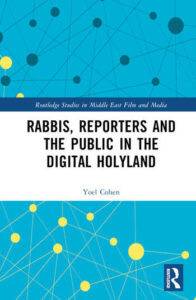REVIEW: Rabbis, Reporters and the Public in the Digital Holyland

 Yoel Cohen, Rabbis, Reporters and the Public in the Digital Holyland (Routledge, 2024), 290 pp.
Yoel Cohen, Rabbis, Reporters and the Public in the Digital Holyland (Routledge, 2024), 290 pp.
Reviewed by Ari L. Goldman
Before he had the massive stroke that would disable him and eventually lead to his death thirty years ago, the Lubavitcher Rebbe, Rabbi Menachem Mendel Schneerson, would stand for hours at his home in Brooklyn and greet his followers and others seeking a blessing.
The encounters took place on what became known as “the dollar line” because the Rebbe would hand each visitor a dollar bill. The idea behind the dollars was twofold: first, it gave the Rebbe a forum for engaging with visitors, both men and women, and, second, it was intended to inspire visitors to give charity. “This is for tzedaka,” he would say, although many kept the Rebbe dollars and matched them with others that they gave to charity.
It was on a Sunday in 1992 when my brother-in-law, Dr. Mordecai Dicker, was on line to receive a blessing from the Rebbe. Mordi came that day for a special reason; he was getting married and hoped for the Rebbe’s blessing. As with many of the Rebbe’s encounters, the moment is captured in a video.
“Bracha vehatzlocha,” the Rebbe tells Mordi as he hands him a dollar bill. And then he hands Mordi a second dollar and says: “This is for Mr. Ari Goldman.”
At the time, I was a reporter for The New York Times. As if Mordi didn’t know, the Rebbe adds this bit of information about me: “He writes from time to time about Lubavitch.”
“Yes,” Mordi responds with a smile. “He is my brother-in-law.”
The Rebbe continues: “If he knows I am reading it, he’ll probably write even better than he has until now.”
This exchange was truly remarkable. Here was the Rebbe dealing with people who were hopeful or hurting or despairing. He wanted to be there to help them, but he also cared about getting good press for the Jews. More than any other Jewish leader, the Rebbe was a master publicist.
Rabbi Schneerson smartly used the press to get out his message. Few did it so well, Yoel Cohen, a professor of mass communication at Ariel University in Israel, writes in his new book, Rabbis, Reporters and the Public in the Digital Holyland.
Each day, Cohen notes, the Rebbe’s staff handed him a stack of articles clipped from the daily press. These articles were not just about Judaism but about science, medicine, and astronomy. “The Rebbe was up-to-date on everything,” the Chabad spokesman, Rabbi Yehuda Krinsky, told Cohen.
“Did the press have an impact on the Rebbe?” Krinsky asked rhetorically and then answered his own question. “It was the Rebbe who had the impact, not vice versa. There’s no tail wagging the dog” here.
In Cohen’s new book, he explains this two-way street with a sharp focus on the media in Israel. How well does the Israeli press do its job when it covers Judaism? And how does the media influence religious leaders? If Cohen were writing this book 35 years ago, his inquiry might have ended there—but there’s another element to this relationship in the 21st century, namely the role of the public who, through social media, are very much partners in this relationship, which has gone from two-directional to triangular.
 This is an academic book, thick with statistical analysis and data on everything from social media use to news habits to lashon ha-ra. Cohen has compiled extensive research on the role of mass media in the lives of rabbis, reporters, and the public. Who knew that the average Israeli household has 12 connections to the Internet (whether through smartphone, computer, or tablet) and that 90 percent of Israelis with Internet are linked to WhatsApp? Cohen shares data on Israeli shopping habits, online medical consults, social media preferences, and more. He presents journalists’ views on rabbis and rabbis (across the ideological and religious spectrum) opinions about journalists. The portrait that emerges is a “clash of cultures” between the clergy and the press.
This is an academic book, thick with statistical analysis and data on everything from social media use to news habits to lashon ha-ra. Cohen has compiled extensive research on the role of mass media in the lives of rabbis, reporters, and the public. Who knew that the average Israeli household has 12 connections to the Internet (whether through smartphone, computer, or tablet) and that 90 percent of Israelis with Internet are linked to WhatsApp? Cohen shares data on Israeli shopping habits, online medical consults, social media preferences, and more. He presents journalists’ views on rabbis and rabbis (across the ideological and religious spectrum) opinions about journalists. The portrait that emerges is a “clash of cultures” between the clergy and the press.
Rabbis of all stripes (from left to right) agreed that secular websites damage religious values. While journalists champion “the right to know,” Cohen writes, rabbis champion “the right to privacy” and worry about sexual modesty and social gossip. They are especially concerned about reporting on rabbinic sexual scandals.
One question he asks is: “Should immoral deeds by rabbis be reported in the media?” The non-Orthodox were the most in agreement, with 82 percent favoring publication. The Modern Orthodox were less inclined toward such disclosures and the Haredi rabbis even less so. Cohen concludes: “While rabbis feared that such information would cause a hilul Hashem, they did acknowledge that [such disclosures] had a deterring effect on other rabbis.”
Cohen does a deep dive into the Israeli press and finds one religious topic dominates the coverage. That topic is not sex scandals but Sabbath observance (or the lack of it). In fact, there are far more articles about the Sabbath than there are stories about sex, God, prayer, Haredim, the Vatican, brit mila, or aguna. (Cohen does not include politics in his list of religious themes, although I suspect that if he did have a “religion and politics” category that might overwhelm Shabbat or sex.)
Still, with all the data that Cohen shares, this is also a well-written and largely accessible book. It includes a good dose of sophisticated halakhic analysis. I particularly enjoyed his chapter on Jewish values and the media. He invokes the Hafetz Hayyim, Rambam, and Rabbi Abraham Isaac Kook and even David Ben-Gurion.
The Torah provides us with a guide for writing about the bad, Cohen says. “The Torah not only praises its heroes, but also criticizes them,” Cohen notes. God does not shy away from this criticism and neither do His Prophets who speak out against the wrongdoings of the leadership and the people. “That Leviticus 19:16 prohibits the disclosure of secret information,” he writes, “suggests that if somebody, including a journalist, hears of information, such as corruption… he or she has an obligation to take steps to rectify this situation.” And, then, quite boldly he adds: “The Bible, therefore, acknowledges the fourth estate role, or societal watchdog, fulfilled by the media.”
Cohen goes on to discuss the Hafetz Hayyim and his rules – and exceptions – about gossip, particularly in a case when the only way to weed out corruption is to go public with it. He calls this “the Jewish theory of communication.” Negative information, Cohen writes, “should be published only if the information is entirely accurate and on condition that, in disclosing it, the reporter has the public good as his goal and that there is no other way to achieve that goal other than by going public.”
This, Cohen acknowledges, is the exception, not the rule which is to avoid lashon ha-ra at (almost) all costs. “In contrast to Western society and media, which is characterized by the right to privacy as subservient to the right to know,” Cohen writes, “rabbis regard the right to know as subservient to the right to privacy.” Still, scholars have differed on the finer points of disclosure. For example, he writes, Rambam “distinguished between information about distant events, such as events associated with the elite, and information about individuals nearer to the discloser of the information, the latter of which it is forbidden to publish.” Hafetz Hayyim took a more stringent approach, forbidding disclosures of those both near and far. On the other hand, Rav Kook, “recognized that the press had an integral part to play in modern nation-building, and notwithstanding that Kook did favor that media behavior should be more attuned to Jewish values.”
My favorite nugget about the role of media in Israel comes not from Cohen’s discussion about the rabbis but his mention of Israel’s first prime minister, David Ben-Gurion. Ben-Gurion, Cohen writes, was opposed to the spread of television stations and television sets in Israel. According to an article in the Jerusalem Post, Ben-Gurion’s antipathy to television began with a visit to California in 1952 when someone set up a black and white television in his hotel room. “If that is TV,” he declared, “we shall never have it in Israel.”
Television didn’t come to Israel until after the 1967 war when Ben-Gurion was already out of power and the government felt that it needed to counter Arab television broadcasts to Arab populations in areas captured in the Six-Day War. But what was Ben-Gurion’s real reluctance? Cohen explains: Ben-Gurion regarded television as “unsuitable for the People of the Book.” One can only imagine what the “Old Man,” as B-G was affectionately known, would say about TikTok.
My suggestion is to turn off your television, disconnect from the Internet for a few hours, and enjoy Cohen’s book.
Ari L. Goldman is a Professor Emeritus at Columbia University’s Graduate School of Journalism.
